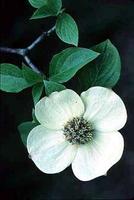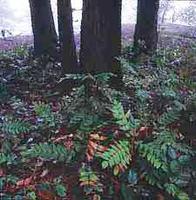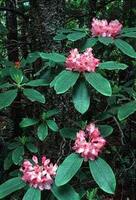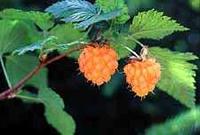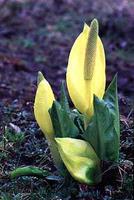Plants, Native
PLANTS, NATIVE, including trees, shrubs, herbs and grasses, FERNS, MOSSES, liverworts, lichens and fungi, number over 15,000 species in BC. These include an estimated 2,073 vascular plants, about 1,000 bryophytes (mosses and liverworts), 1,600 lichens, 522 species of algae and over 10,000 species of fungi. Some of these plants are huge, such as giant Sitka SPRUCE, western red CEDAR and DOUGLAS FIR (see also FORESTS; TREES, GIANT), while others are practically microscopic and are more easily seen when many grow in one location, such as some mosses and lichens. Some of the native plant species in BC are truly ancient—coastal RAIN FORESTS have existed for about 2 million years and contain species that evolved 70 million years ago—and some species have only been here for a few thousand years, having moved northward because of the warmer CLIMATE since the last GLACIATION ended about 10,000 years ago. Remnants of these ancient forests contain trees that are over 1,500 years old. In BC, 595 native vascular plant species, close to 30% of the total, are considered to be at risk (see ENDANGERED SPECIES).
Since the dawn of time, societies have used native plants for sustenance and cultural and economic purposes. In many cases, as in BC, the plants and their uses have in large part helped define a culture. BC's aboriginal inhabitants relied on at least 200 species of native plants for a variety of food, medicinal, ceremonial and technological uses. Depending on the season, they used virtually all parts of various food plants: in spring, the bulbs and shoots; in summer and fall, the flowers, nuts and seeds; and in winter and early spring, the roots. BERRIES were eaten fresh and dried, or mixed with the flesh of fish and other animals to help preserve them, add flavour and increase nutritional content. Western red cedar was one of the principal plants used by coastal people for building and for making clothing, boxes, baskets, CANOES and TOTEM POLES. While LOGGING is the principal use of native trees today, some are gaining a reputation as a source for medicines, such as the cancer drug taxol, which is derived from YEW. There is a burgeoning industry in picking native MUSHROOMS (fungi), although this practice may turn out to be harmful to the ecosystems in which they grow. SALAL is another native plant that has been harvested commercially by florists for enhancing floral bouquets.
Wildlife populations in BC also depend completely on native plants, since these are the species alongside which they have evolved. When the ecosystems that support native plants are altered or lost, so too are the animal species that depend on them. An example is the dwindling population of mountain CARIBOU in the KOOTENAY region: clearcut logging from valley bottom to mid-elevation into the subalpine there has altered the ecosystems in which arboreal lichens thrive, and arboreal lichens are practically the only food source for mountain caribou throughout 7–8 months of winter conditions. See also BIODIVERSITY.
by Maggie Paquet

